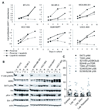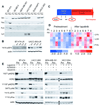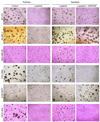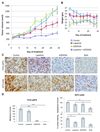Phosphoproteomic mass spectrometry profiling links Src family kinases to escape from HER2 tyrosine kinase inhibition
- PMID: 21499296
- PMCID: PMC3204390
- DOI: 10.1038/onc.2011.130
Phosphoproteomic mass spectrometry profiling links Src family kinases to escape from HER2 tyrosine kinase inhibition
Abstract
Despite the initial effectiveness of the tyrosine kinase inhibitor lapatinib against HER2 gene-amplified breast cancers, most patients eventually relapse after treatment, implying that tumors acquire mechanisms of drug resistance. To discover these mechanisms, we generated six lapatinib-resistant HER2-overexpressing human breast cancer cell lines. In cells that grew in the presence of lapatinib, HER2 autophosphorylation was undetectable, whereas active phosphoinositide-3 kinase (PI3K)-Akt and mitogen-activated protein kinase (MAPK) were maintained. To identify networks maintaining these signaling pathways, we profiled the tyrosine phosphoproteome of sensitive and resistant cells using an immunoaffinity-enriched mass spectrometry method. We found increased phosphorylation of Src family kinases (SFKs) and putative Src substrates in several resistant cell lines. Treatment of these resistant cells with Src kinase inhibitors partially blocked PI3K-Akt signaling and restored lapatinib sensitivity. Further, SFK mRNA expression was upregulated in primary HER2+ tumors treated with lapatinib. Finally, the combination of lapatinib and the Src inhibitor AZD0530 was more effective than lapatinib alone at inhibiting pAkt and growth of established HER2-positive BT-474 xenografts in athymic mice. These data suggest that increased Src kinase activity is a mechanism of lapatinib resistance and support the combination of HER2 antagonists with Src inhibitors early in the treatment of HER2+ breast cancers in order to prevent or overcome resistance to HER2 inhibitors.
Conflict of interest statement
The authors declare no conflict of interest.
Figures





Similar articles
-
Direct inhibition of PI3K in combination with dual HER2 inhibitors is required for optimal antitumor activity in HER2+ breast cancer cells.Breast Cancer Res. 2014 Jan 23;16(1):R9. doi: 10.1186/bcr3601. Breast Cancer Res. 2014. PMID: 24451154 Free PMC article.
-
Epidermal growth factor-receptor activation modulates Src-dependent resistance to lapatinib in breast cancer models.Breast Cancer Res. 2014 May 5;16(3):R45. doi: 10.1186/bcr3650. Breast Cancer Res. 2014. PMID: 24887236 Free PMC article.
-
An heregulin-EGFR-HER3 autocrine signaling axis can mediate acquired lapatinib resistance in HER2+ breast cancer models.Breast Cancer Res. 2013;15(5):R85. doi: 10.1186/bcr3480. Breast Cancer Res. 2013. PMID: 24044505 Free PMC article.
-
Lapatinib.Recent Results Cancer Res. 2018;211:19-44. doi: 10.1007/978-3-319-91442-8_2. Recent Results Cancer Res. 2018. PMID: 30069757 Review.
-
Lapatinib: a small-molecule inhibitor of epidermal growth factor receptor and human epidermal growth factor receptor-2 tyrosine kinases used in the treatment of breast cancer.Clin Ther. 2009;31 Pt 2:2332-48. doi: 10.1016/j.clinthera.2009.11.029. Clin Ther. 2009. PMID: 20110044 Review.
Cited by
-
PP2A: The Wolf in Sheep's Clothing?Cancers (Basel). 2015 Apr 10;7(2):648-69. doi: 10.3390/cancers7020648. Cancers (Basel). 2015. PMID: 25867001 Free PMC article. Review.
-
Interleukin-6 expression contributes to lapatinib resistance through maintenance of stemness property in HER2-positive breast cancer cells.Oncotarget. 2016 Sep 20;7(38):62352-62363. doi: 10.18632/oncotarget.11471. Oncotarget. 2016. PMID: 27694691 Free PMC article.
-
Rictor/mTORC2 Drives Progression and Therapeutic Resistance of HER2-Amplified Breast Cancers.Cancer Res. 2016 Aug 15;76(16):4752-64. doi: 10.1158/0008-5472.CAN-15-3393. Epub 2016 Apr 25. Cancer Res. 2016. PMID: 27197158 Free PMC article.
-
NCAPG confers trastuzumab resistance via activating SRC/STAT3 signaling pathway in HER2-positive breast cancer.Cell Death Dis. 2020 Jul 18;11(7):547. doi: 10.1038/s41419-020-02753-x. Cell Death Dis. 2020. PMID: 32683421 Free PMC article.
-
Design, Synthesis, Biological Evaluation, and Molecular Dynamics Studies of Novel Lapatinib Derivatives.Pharmaceuticals (Basel). 2022 Dec 28;16(1):43. doi: 10.3390/ph16010043. Pharmaceuticals (Basel). 2022. PMID: 36678540 Free PMC article.
References
-
- Belsches-Jablonski AP, Biscardi JS, Peavy DR, Tice DA, Romney DA, Parsons SJ. Src family kinases and HER2 interactions in human breast cancer cell growth and survival. Oncogene. 2001;20:1465–1475. - PubMed
-
- Berns K, Horlings HM, Hennessy BT, Madiredjo M, Hijmans EM, Beelen K, et al. A functional genetic approach identifies the PI3K pathway as a major determinant of trastuzumab resistance in breast cancer. Cancer Cell. 2007;12:395–402. - PubMed
-
- Biscardi JS, Maa MC, Tice DA, Cox ME, Leu TH, Parsons SJ. c-Src-mediated phosphorylation of the epidermal growth factor receptor on Tyr845 and Tyr1101 is associated with modulation of receptor function. J Biol Chem. 1999;274:8335–8343. - PubMed
Publication types
MeSH terms
Substances
Grants and funding
LinkOut - more resources
Full Text Sources
Other Literature Sources
Molecular Biology Databases
Research Materials
Miscellaneous

